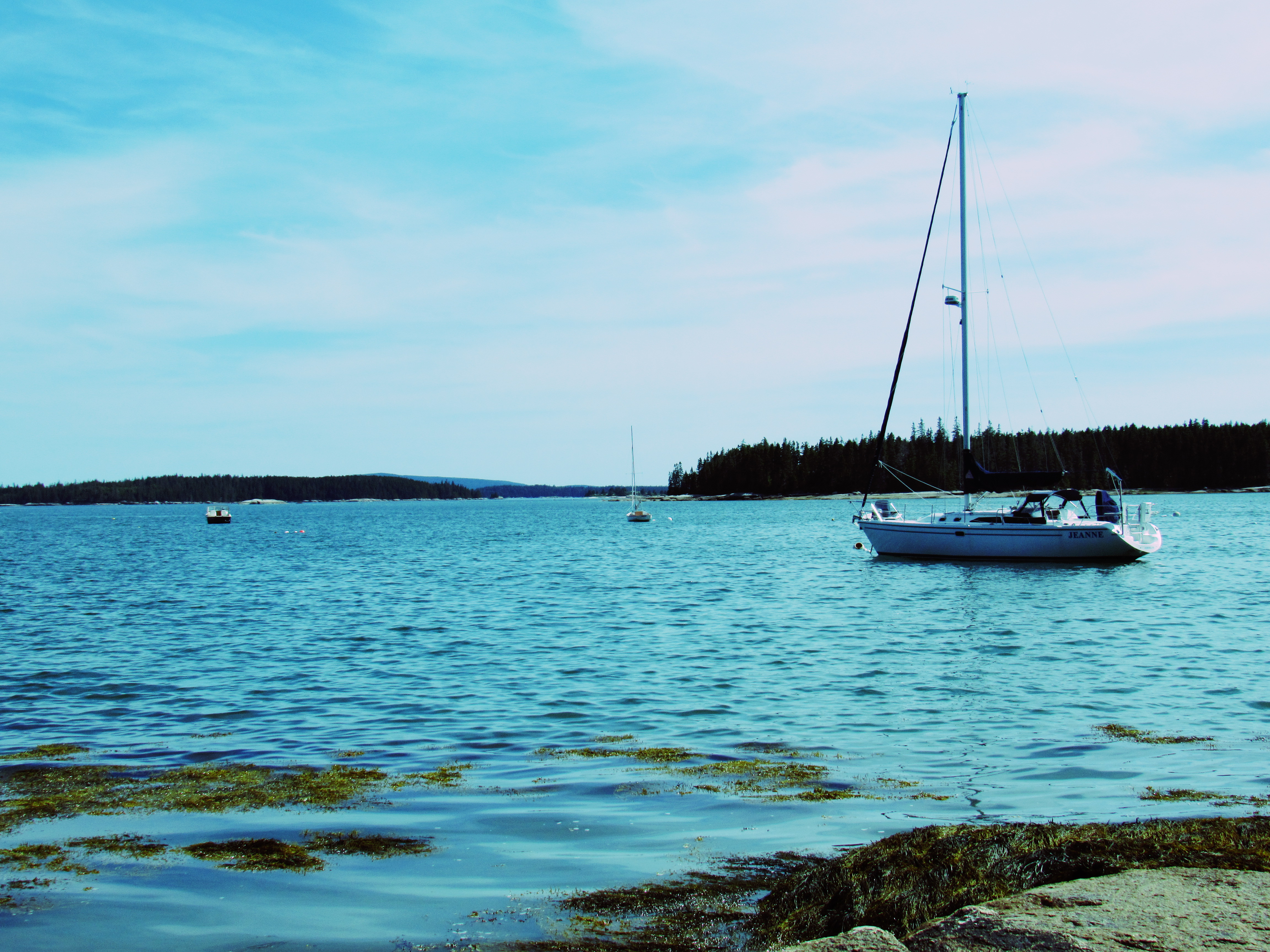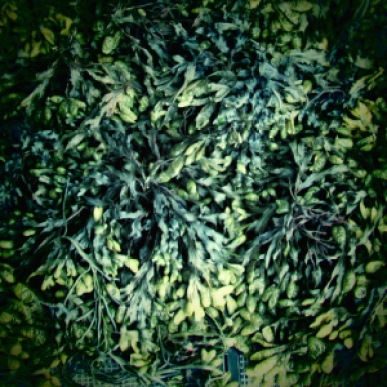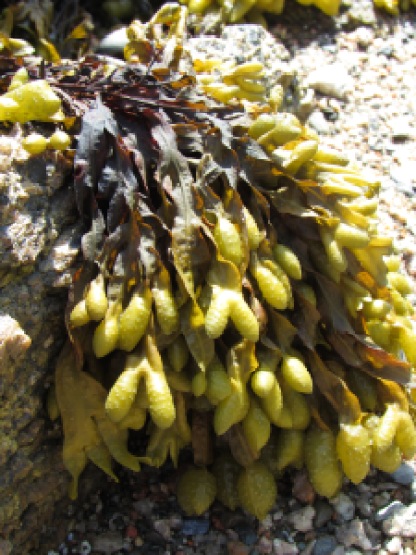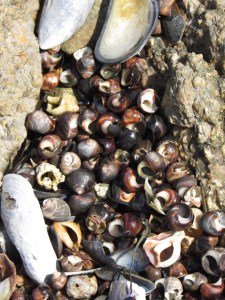If I was better at handling winter, I’d be moving to Maine.
In mid-July, despairing of finding any sizable quantity of St. John’s wort for my apothecary and feeling restless in what Vermonters call “heat,” I headed to the Maine coast with a companion to find out what my friend Micah has been doing these past four years.
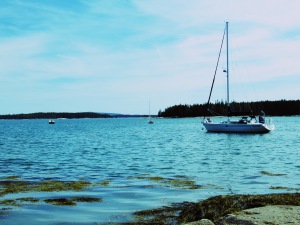 Turns out, he’s been living on a magical island that you can only get to by boat. Micah is the founder of the Atlantic Holdfast Company, a small labor of hand-harvested love, bringing you the loveliest cuts of seaweeds that Neptune is willing to part with. He spends his time harvesting vegetables from ledges awash in salt water with a serrated knife, under the curious gazes of dog-like seals who venture in only occasionally for a nibble.
Turns out, he’s been living on a magical island that you can only get to by boat. Micah is the founder of the Atlantic Holdfast Company, a small labor of hand-harvested love, bringing you the loveliest cuts of seaweeds that Neptune is willing to part with. He spends his time harvesting vegetables from ledges awash in salt water with a serrated knife, under the curious gazes of dog-like seals who venture in only occasionally for a nibble.
Micah picked us up from a dock on the southern tip of Deer Isle in a friend’s lobstering boat, which we traded halfway through the Penobscot Bay for a much smaller vessel with an outboard motor. Micah positioned my pal and me just so in the boat, in order to balance the weight in the laden vessel. I learned quickly to tuck my feet under a weighty cooler to prevent myself from being cast overboard in the substantial wind.
 After a good half hour of motoring out, we arrived thoroughly goosebumped at a small isle covered in St. John’s wort, and so I was immediately satisfied, notwithstanding the epic kelp harvesting, rock-hopping, beach-combing, and roasted goat and lobster dinner in our immediate futures.
After a good half hour of motoring out, we arrived thoroughly goosebumped at a small isle covered in St. John’s wort, and so I was immediately satisfied, notwithstanding the epic kelp harvesting, rock-hopping, beach-combing, and roasted goat and lobster dinner in our immediate futures.
The daily activities of seaweed harvest are of the gutsy gritty romance that characterizes many of Maine’s industries. Several hours before the lowest tide of the month, my friend and I headed down to the barn where the seaweed and wetsuits were hung to dry. My pal and I struggled into our wetsuits as if the suits were actually exercise accoutrements designed to help us achieve and sustain effortful contorted positions. Half an hour later, after accomplishing ten chores in as many minutes, Micah came along and slipped into his suit like an easy second skin over rearrangable limbs.

We piled more equipment into the boat, waded in, and pushed off, the spray upon my glasses offering an impressionist’s view of the sea and sky. After another half hour, we arrived at several exposed ledges that Micah identified as prime seaweed territory. With a serrated knife in my right hand and in my left the rope to an inner tube with a harvesting basket stuffed in it and floating upon the curl, I threw myself overboard into four feet of sucking tides and slippery seaweed-covered rock.
We were after Digitata, the many-fingered kelp, and all the while the spidery Alaria fronds curled raggedly around our waists and thighs as the tides tried their damnedest to swallow me or at least laugh insanely as my tiny human attempt to balance upon two legs. To harvest the Digitata required that I reach into water up to my shoulder and grasp the stipe with an inarticulate gloved hand. The stipe was often as thick around as I could grasp, and without allowing the chaos to interfere with my sawing, I’d cut through the meat of it in order to retrieve 2-4 inches of stipe and all of the frond. Micah had an eye for the amount he wanted to harvest in order to manage the patch sustainably. Just when I was starting to wonder whether I was in control of the bucket full of seaweed or the bucket was in control of me, Micah shouted for us to hoist ourselves back in the boat, a feat which I was able to execute inelegantly thanks only to the quantity of pull-ups required in the study of acrobatics.
This all occurred between 4:30 am and 7:30 am.
Let me be clear, I was inordinately thrilled by every single moment of the harvest and would encourage anyone looking for a foraging adventure to test her sea legs. Pay no mind to the sizable seal nosing at your toe.
Being the smallest of our threesome — I have since learned from a Vermont natural science museum that the smallest animals often don’t survive the winter simply because of mass — I went directly under the covers upon our return to the cabin on the flower-covered isle and shivered for the better part of two hours. When I woke, I ate an enormous quantity of bacon and eggs, feta and cucumbers, walnuts and dates, and squares of dark chocolate.
Around noon, we returned to the boat, which had been pushed in to us by the tide, and we spent the happy part of an hour hauling buckets of wet seaweed up to the barn. My friend and I used a little yellow cart, which I pushed and he pulled, and we’d delivery the slippery vegetables to barn, where Micah had designed several ingenious sets of pullies and racks and ropes to haul the seaweed from the bottom of the barn to the second story.
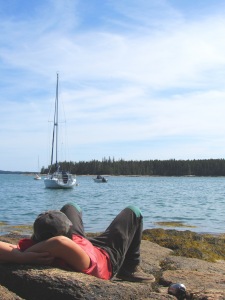 Seaweeds begin to exude alginates after an hour of so out of the water, and so I had the sensation of having my hands covered in mermaid sneezes as I hung the muppet-like plants on thin wooden sticks in their specially-constructed racks.
Seaweeds begin to exude alginates after an hour of so out of the water, and so I had the sensation of having my hands covered in mermaid sneezes as I hung the muppet-like plants on thin wooden sticks in their specially-constructed racks.
Processing plants — shucking corn, pruning garlic, stripping leaves from dried tulsi, pinching golden ground cherries from their papery lantern husks — is one of the most intimate times for human-plant and human-human bonding. The plants slither or crumble or shed all over you according to their natures, and we homo sapiens catch up on all the gossip since we last we met: what its like to find a date in rural New England, the after-hours shenanigans of the neighboring lobstermen, the best way to butcher a goat, farming versus foraging. The usual.
After hanging the Digitata to dry, I had another nap, and then in the late afternoon my comrade and I wandered the perimeter of the island, past a giant elderberry tree covered in soft flowers, over rocky inlets ridden with buoys and lobster crates washed ashore, past Rosa rugosa thickets heavy with green hips, through patches and patches of wild raspberries, and up into the arms of a giant old rowan tree covered in the droppings of a raccoon tucking in to the early raspberries.
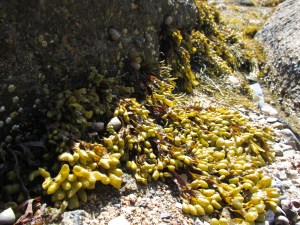 Along the shore we gathered the bladderwrack, which lay like the pocketed hair of mermaids, sucked at by the rocks at the water’s edge. We bent amid the tumble of boulders to snip the seaweed and pile it into our buckets. Bladderwrack has an odd mineral butter aroma, strongly of the sea and also sort of animal-ish. Micah recommended that we start to dry the seaweed in the car on the way home, and then grind it, as it was best as an additive or condiment to dishes or smoothies.
Along the shore we gathered the bladderwrack, which lay like the pocketed hair of mermaids, sucked at by the rocks at the water’s edge. We bent amid the tumble of boulders to snip the seaweed and pile it into our buckets. Bladderwrack has an odd mineral butter aroma, strongly of the sea and also sort of animal-ish. Micah recommended that we start to dry the seaweed in the car on the way home, and then grind it, as it was best as an additive or condiment to dishes or smoothies.
So that’s what I did. First on the porch in the sun, then finished it off in my dehydrator. A coffee grinder did the job just fine. What a particular plant this is! Here are some things I’ve learned about it since.
Fucus vesiculosis (the species name meaning “little vesicles,” for the sealed air pockets that float the stuff) is the Latin binomial for the brown seaweed bladderwrack, a form of kelp famous for its ability to stimulate sluggish thyroid function. High in a form of iodine which is the immediate precursor to the thyroid hormones T3 and T4, bladderwrack is also highly nutritive, demulcent, and stimulating to cellular metabolism. The specific indications for use of this sea vegetable medicinally include both energetic and constitutional pictures as well as discreet diagnoses.
+ Depeletion: Bladderwrack in dense in micronutrients besides iodine, including calcium, magnesium potassium, sodium, silicon, iron, vitamin D, many B-complex vitamins, as well as essential fatty acids. The powdered sea vegetable is useful in debility, poor digestion, post-surgery, convalescence, postpartum, and other situations where remineralization is necessary. Particularly indicated for lethargy, dry skin and membranes, constipation resulting from dryness, and slow cognitive and physical development in children.
+ Chronic and Systemic Inflammation: Hot baths, compresses, and oral supplementation with bladderwrack is often recommended in rheumatic conditions. Treatments have been documented to relieved sore and achy joints and muscles as well as stimulate cartilage growth.
+ Adrenal and Immune Function: Studies have shown bladderwrack to improve duration and quality of sleep, promote tissue healing, and support anti-viral activity. Fucoidan is a compound found in brown seaweeds which has been shown to interfere with all stages of viral attack as well as will proliferation of human cancer cells. Dr. Drum even points out that all human cells studied have receptors for Fucose, the end-group sugar on the Fucoidan compound.
+ Metabolic and Cardiovascular Function: Bladderwrack added into the diet delays hardening of the arteries, lowers chronically high blood pressure, and stimulates cellular metabolism — all conditions correlated with low thyroid function.
SAVORY MORNING OATS!
This is my chance to share my favorite breakfast recipe, an not-sweet oatmeal recipe that I prefer for its ability to sustain the body through cold and hard-working mornings.
INGREDIENTS
Steel-cut or rolled oats, soaked 2-24 hours, drained 1 tablespoon ground bladderwrack or other seaweed 1 shredded carrot 2 tablespoons sunflower seeds, pumpkin seeds, sesame seeds, and/or walnuts 1-2 pats of butter or coconut oil 1-2 teaspoons fresh-ground black pepper Nutritional yeast or miso as desired
+ Bring water for oats to a boil, adding an extra half-cup to account for seaweed addition. + Upon boil, add oats, ground bladderwrack, and nuts and seeds. + Reduce to a simmer until oats are tender, as desired + Remove from heat and add remaining ingredients. + Easy peasy!
Maude Grieve. Bladderwrack. A Modern Herbal. https://www.botanical.com/botanical/mgmh/b/bladde54.html
Ryan Drum. Sea Vegetables for Food and Medicine. http://www.ryandrum.com/seaxpan1.html
Herbal Riot. The Magickal Uses of Bladderwrack. http://herbalriot.tumblr.com/post/56686839194/the-magickal-uses-of-bladderwrack
